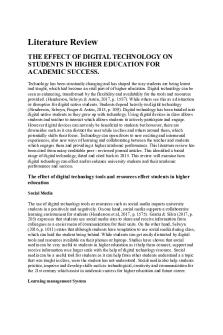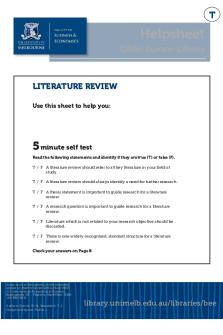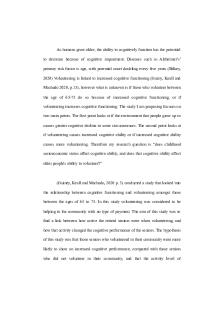Literature Review PDF

| Title | Literature Review |
|---|---|
| Author | Gracie Richter |
| Course | IMC |
| Institution | Queensland University of Technology |
| Pages | 9 |
| File Size | 161 KB |
| File Type | |
| Total Downloads | 66 |
| Total Views | 153 |
Summary
Synergy in IMC Lit review ...
Description
Synergy in IMC Literature Review
Abstract The purpose of this literature review is to gain insight into the current academic climate surrounding to what extent synergy is a critical tool for successful Integrated Marketing Communications (IMC). It will conclude that synergised IMC leads to increased return on investments and positively affects consumers perceived image and trust of the brand. The literature review will cover three key areas of academic focus; how synergy is defined in an IMC context, the importance of synergy and the challenges in achieving synergy in IMC contexts. 1. Introduction IMC Frameworks can be understood as both a concept and process that has been developed through both literature and practice over the last 20 years (Suklan et al., 2015; Kitchen & Burgmann, 2015). The shifting media landscape and increase of online platforms has seen significant changes in the way in which businesses operate their marketing communication channels in order to remain competitive in the market (Naik & Raman, 2003; Duncan, 1993). Hence there has been a movement for businesses to now operate across a variety of traditional and digital channels which now offers more effective and synchronised delivery of marketing material to audiences and also enhances consumer’s purchasing power (O’Donohoe, & Kelly 2010; Naik & Raman, 2003). Academics acknowledge historically marketing communications were measured on a medium-by-medium basis meaning there would be one measure for sales, advertising, public relations and so on (Matovic et al., 2015, Kitchen & Burgmann, 2015). Rather, it is suggested that businesses must strategically select a combination of promotional tools and media to deliver greater returns on both investments and attitudinal and behavioural impacts rather than any of those tools would being used in isolation (Ewing, 2009, Kitchen & Burgmann, 2015). Ewing (2009) offers that “All things being equal, and assuming some sound media and strategic planning, the whole (integrated) campaign should be greater than the sum of the individual parts”.
Page 1 of 9
1.1. Defining Synergy in an IMC Context Overwhelmingly scholars adopt the American Association of Advertising Agencies (1989) IMC definition recognising the significance of value added to marketing communications from a comprehensive plan that strategically evaluates the roles of a variety of communication disciples such as general advertising, direct response, public relations and sales promotion and combines these disciples to provide maximum communications impact through increased clarity and consistency (Belch and Belch, 2009). Both this definition and scholars emphasise the importance of synergistic marketing communications that utilise multiple tools that capitalises on the strengths of each to achieve successful outcomes which would otherwise be absent if tools were used independently (Brown 1997; Kliatchko, 2005).
2. Importance of Synergy in an IMC Context Increasing new technologies has introduced various channels which consumers can interact with products and brands (Barwitz, & Maas, 2018; Dellaert, 2019), allowing consumers to have increased control in how they interact with brands (Harmeling et al. 2017). Hence academics note the importance of observing touchpoints across various channels as observing them individually can lead to incorrect conclusions (Lemon & Verhoef, 2016; Li & Kannan, 2014). Applying synergised integrated marketing communications provides a robust solution to navigate the complex 21 st century communication landscape (Key & Czaplewski, 2017). Academics suggest consumers engage with a number of touchpoints with the assistance of brands, technologies, products and services to undertake complex emotional and experiential journeys (Hamilton & Price, 2019; Akaka, & Schau, 2019). Empirical evidence has found that synergised IMC has positive economic effects on purchasing behaviours in the food Page 2 of 9
sector through implementing consistent brand messaging through multiple channels (Đokić, 2018). Further studies have found that synergised marketing communications lead to greater returns on investments as brand awareness is increased and target customers positively perceive brands to have higher value and more credibility (Tamošiūniene & Jasilioniene, 2007; Racolta-Paina & Luncasu, 2007). A study of the IMC elements in Avon Cosmetics found that 86% of respondents would recommend and promote the use of Avon products as a result of interacting with the brand across direct and indirect marketing, advertising, sales promotions, public relations and sponsorships (RacoltaPaina & Luncasu, 2007). When consumers positively perceive brands (which is enhanced through IMC elements) research indicates relational bonds are strengthened which enhances both trust and profits between consumers and brands (Mihaela, 2015; Tamošiūniene & Jasilioniene, 2007).
3. Challenges of achieving Synergy in an IMC Context A key challenge of achieving synergy in IMC that has been identified by academics for businesses to overcome is the need for total organisational cohesion. Managerial concerns to be overcome in implementing IMC programs include the involvement and commitment of top managers, organisational structures, cross-functional training of staff, financial considerations and the development of a ‘culture of marketing’ embedded in the business’s corporate philosophy (Kliatchko, 2005, Kitchen & Burgmann, 2015). This assessment supports that synergised IMC development and execution encompasses more than just creating on brand marketing campaigns or integrating formerly separate areas such as public relations and advertising. Kliatchko (2005) asserts that:
Page 3 of 9
As the power continues to shift from the manufacturer to the consumer in today’s marketplace, communication should not be considered merely as a support or a tactical activity, but as a strategic management tool seen in terms of investments, returns, and how it contributes to business results and the success of the organisation as a whole (Schultz & Schultz, 1998). However, despite that IMC should start at the senior level, research suggests that this rarely occurs (Swain, 2004). Senior managers ought to be highly engaged in the application of IMC procedures throughout the organization (Kitchen & Burgmann, 2015).
4. Conclusion Overall, this literature review has demonstrated that synergy has a well-founded place in IMC frameworks and businesses should develop their marketing communication to be cohesive across all mediums (Naik & Raman, 2003; Matovic et al., 2015). Developing numerous touchpoints to engage with consumers has been found to be effective in increasing economic benefits as well as purchasing behaviours (Đokić, 2018; RacoltaPaina & Luncasu, 2007). Future studies should harness new methodologies as the media landscape continues to evolve with new technology which offers exciting opportunities for researchers to assess consumer characteristics and consumer qualities.
Page 4 of 9
References Akaka, M., & Schau, H. (2019). Value creation in consumption journeys: recursive reflexivity and practice continuity. Journal of the Academy of Marketing Science, 47(3), 499–515. https://doi.org/10.1007/s11747-019-00628-y Barwitz, N., & Maas, P. (2018). Understanding the Omnichannel customer journey: determinants of interaction choice. Journal of Interactive Marketing, 43, 116–133. https://doi.org/10.1016/j.intmar.2018.02.001 Belch, G., & Belch, M. (2009). Advertising and promotion: an integrated marketing communications perspective (8th ed.). McGraw-Hill Irwin. Brown, J. (1997) Impossible dream or inevitable revolution? Investigating the concept of integrated marketing communications. Journal of Communication Management, 2(2), 70–81. https://doi.org/10.1108/eb023449 Dellaert, B. (2019). The consumer production journey: marketing to consumers as coproducers in the sharing economy. Journal of the Academy of Marketing Science, 47(2). https://doi.org/10.1007/s11747-018-0607-4 Đokić, I. (2018). Economic effects of integrated marketing communications: The case of food products. Ekonomika Poljoprivrede (1979), 65(3), 985–994. https://doi.org/10.5937/ekoPolj1803985D Duncan, T. (1993). Integrated marketing? It’s synergy. Advertising Age, 64(10), 22. http://search.proquest.com/docview/208308828/ Ewing, M. (2009) Integrated marketing communications measurement and evaluation, Journal of Marketing Communications. 15(2-3), 103-117. https://doi.org/10.1080/13527260902757514
Page 5 of 9
Hamilton, R., & Price, L. (2019). Consumer journeys: developing consumer-based strategy. Journal of the Academy of Marketing Science, 47(2), 187–191. https://doi.org/10.1007/s11747-019-00636-y Harmeling, C., Moffett, J., Arnold, M., & Carlson, B. (2017). Toward a theory of customer engagement marketing. Journal of the Academy of Marketing Science, 45(3), 312–335. https://doi.org/10.1007/s11747-016-0509-2 Key, T., & Czaplewski, A. (2017). Upstream social marketing strategy: An integrated marketing communications approach. Business Horizons, 60(3), 325–333. https://doi.org/10.1016/j.bushor.2017.01.006 Kitchen, P., & Burgmann, I. (2015). Integrated marketing communication: making it work at a strategic level. Journal of Business Strategy, 36(4), 34–39. https://doi.org/10.1108/JBS-05-2014-0052 Kliatchko, J. (2005) Towards a new definition of Integrated Marketing Communications (IMC), International Journal of Advertising, 24(1), 7-34. https://doi.org/10.1080/02650487.2005.11072902 Lemon, K., & Verhoef, P. (2016). Understanding Customer Experience Throughout the Customer Journey. Journal of Marketing, 80(6), 69–96. https://doi.org/10.1509/jm.15.0420 Li, H., & Kannan, P. (2014). Attributing Conversions in a Multichannel Online Marketing Environment: An Empirical Model and a Field Experiment. JMR, Journal of Marketing Research, 51(1), 40–56. https://doi.org/10.1509/jmr.13.0050 Matovic, V., Knezevic, M., & Brankov, T. (2015). The Necessity to Adjust Traditional Integrated Marketing Communications Tools and Techniques to New Global Trends. Ekonomika, 61(4), 141–154. https://doi.org/10.5937/ekonomika1504141M Mihaela, O. (2015). Using Integrated Marketing Communication to Create Longterm Value for a Sustainable Organisation. Case Study: The Bakery Industry in Page 6 of 9
Romania. Analele Universităţii Constantin Brâncuşi Din Târgu Jiu: Seria Economie, 1(3), 130–138. https://doaj.org/article/45a0abfe8f234ce9b21dd53651fda7a3 Naik, P., & Raman, K. (2003). Understanding the Impact of Synergy in Multimedia Communications. JMR, Journal of Marketing Research, 40(4), 375–388. https://doi.org/10.1509/jmkr.40.4.375.19385 O’Donohoe, S, & Kelly, A. (2010) Advertising and Promotion: An Integrated Marketing Communications Approach. International Journal of Advertising, 29(3), 501-504. https://doi.org/10.2501/S0265048710201282 Racolta-Paina, N., & Luncasu, A. (2014). The Sales Force of Multi-Level Marketing Companies in the Context of the Marketing Communications Mix. Case Study: Avon Cosmetics Romania. The Proceedings of the International Conference “Marketing - from Information to Decision.” 185–200. http://search.proquest.com/docview/1628379772/ Schultz, D. & Schultz, H. (1998) Transitioning marketing communication into the twentyfirst century. Journal of Marketing Communications, 4(1), 9–26. https://doi.org/10.1080/135272698345852 Suklan, J., Žabkar, V., & Damij, N. (2015). Extending synergy model in the IMC environment to n-communication channels. In Towards Solving the Social Science Challenges with Computing Methods. 11–22. https://doi.org/10.3726/978-3-653-05249-7 Swain, W. (2004) Perceptions of IMC after a decade of development: who’s at the wheel, and how can we measure success? Journal of Advertising Research, 44(1), 46–65. 10.1017/S0021849904040036
Page 7 of 9
Tamošiūniene, R. & Jasilioniene, R. (2007) Customer relationship management as business strategy appliance: Theoretical and practical dimensions. Journal of Business Economics and Management, 8(1), 69-78. https://doi.org/10.1080/16111699.2007.9636154
Page 8 of 9...
Similar Free PDFs

Literature Review
- 10 Pages

Literature Review
- 9 Pages

Literature Review
- 6 Pages

Literature Review
- 32 Pages

Literature Review
- 9 Pages

Literature Review
- 5 Pages

Literature Review
- 15 Pages

Literature Review
- 4 Pages

Literature Review
- 16 Pages

Systematic Literature Review
- 9 Pages

Mobile Learning Literature Review
- 26 Pages

Literature review on IFRS
- 11 Pages

Literature Review - guidelines
- 4 Pages

Chapter-2: LITERATURE REVIEW
- 48 Pages

Distance Education Literature Review
- 12 Pages
Popular Institutions
- Tinajero National High School - Annex
- Politeknik Caltex Riau
- Yokohama City University
- SGT University
- University of Al-Qadisiyah
- Divine Word College of Vigan
- Techniek College Rotterdam
- Universidade de Santiago
- Universiti Teknologi MARA Cawangan Johor Kampus Pasir Gudang
- Poltekkes Kemenkes Yogyakarta
- Baguio City National High School
- Colegio san marcos
- preparatoria uno
- Centro de Bachillerato Tecnológico Industrial y de Servicios No. 107
- Dalian Maritime University
- Quang Trung Secondary School
- Colegio Tecnológico en Informática
- Corporación Regional de Educación Superior
- Grupo CEDVA
- Dar Al Uloom University
- Centro de Estudios Preuniversitarios de la Universidad Nacional de Ingeniería
- 上智大学
- Aakash International School, Nuna Majara
- San Felipe Neri Catholic School
- Kang Chiao International School - New Taipei City
- Misamis Occidental National High School
- Institución Educativa Escuela Normal Juan Ladrilleros
- Kolehiyo ng Pantukan
- Batanes State College
- Instituto Continental
- Sekolah Menengah Kejuruan Kesehatan Kaltara (Tarakan)
- Colegio de La Inmaculada Concepcion - Cebu
